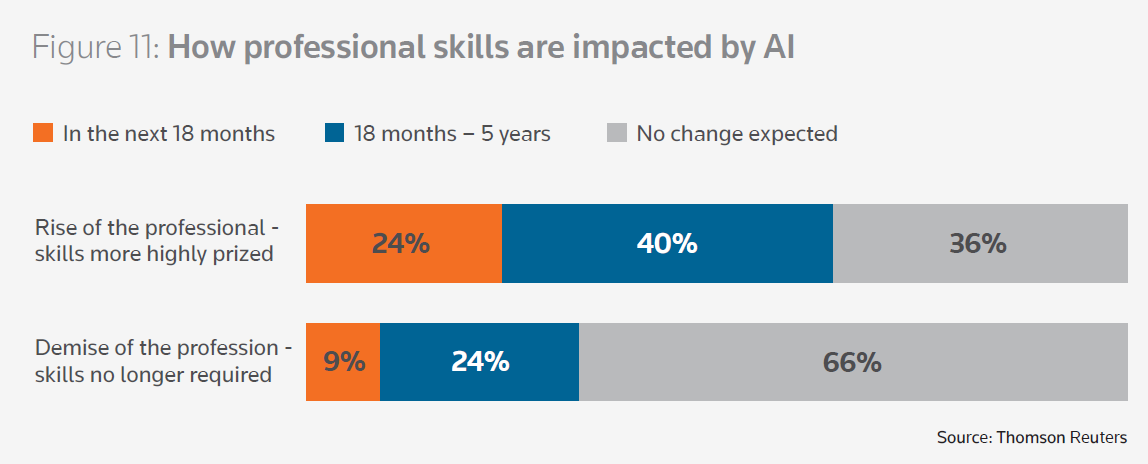In a new blog series, we will look at how small law firms can best navigate the advantages and problems brought by the use of generative artificial intelligence in the workplace
Many lawyers and law firm leaders are worried about the potential disruptive impact of generative artificial intelligence (AI). I’m less convinced that these worries are justified. It’s not that generative AI won’t be disruptive — it will. However, small, agile law firms are in an excellent position to use generative AI-based tools and products to compete with larger, resource-rich law firms in ways that were previously impossible.
I know this because I have seen first-hand how law firms have adopted earlier generations of artificial intelligence into their practices. From the first generations of natural language processing that were built into legal research products decades ago, to more advanced applications for AI in products used for large-scale document reviews, law firms have effectively adapted to new forms of AI when they are embedded in the many products that lawyers use every day.
By strategically implementing early-generation AI technologies, small law firms have achieved greater efficiencies, improved client services, and tapped into analytics and automation, all of which were once the exclusive domain of larger firms. And smaller firms can often pivot to these new capabilities much faster than their inertia-bound large law brethren.
How AI has already boosted the performance of small law firms
Artificial intelligence has already transformed the way small law firms do their work in ways many don’t even realize, especially in areas such as:
Research and document review — AI has been leveraged in legal research and document review for years. Now, a newer generation of research and analysis tools is taking on more of the workflow around these tasks. Traditional time-consuming and labor-intensive research and review work can now be executed in a fraction of the time. Small law firms with limited staffing can leverage these capabilities to take on more cases without compromising the quality of their work, increasing their profitability and competitiveness. Further, this allows smaller firms to take on more client work if they choose to augment billings.
Case analytics — AI-powered data analytics is another area where small firms can level the playing field and go toe-to-toe with large firms. Advanced machine learning algorithms can sift through vast amounts of data to uncover patterns, assess legal precedents, and even predict the likely outcomes of cases. Such analytics were once the purview of large firms that could afford dedicated resources. Now, smaller practices can access similar insights through SaaS (software-as-a-service) platforms at a fraction of the cost. This enables more informed strategic planning and resource allocation, and it can also serve as a powerful tool for client engagement, as firms can offer more precise, data-backed advice — all topics I’ve written about for years.
Client services — Chatbots and AI-driven customer relationship management (CRM) systems can significantly enhance the client experience as well. These tools can handle initial client queries, schedule appointments, and send reminders, offering a level of responsiveness that was previously only possible for large firms with dedicated support staff. Such technologies create an impression of high-quality, attentive service, making small firms more appealing to potential clients. They minimize lawyers’ administrative burden, freeing them up to spend more time on the practice of law. Additionally, utilizing AI in this way will measurably increase the satisfaction of current clients through these service and support enhancements.
Marketing — AI can be a boon for the marketing strategies of small law firms by analyzing market trends, customer behavior, and even the efficacy of previous marketing campaigns. This data can be used to tailor more effective, targeted advertising strategies, enabling small firms to reach their desired audience with a precision that was once only achievable by large firms with extensive marketing budgets. Content for marketing campaigns can be generated and tested with limited effort and expense. And all of this will strengthen the conversion of prospect to client, thus addressing the all-too-important business development need for small law firms.
What generative AI will add to the mix
Generative AI capabilities go well beyond the changes that AI has already brought to legal work, in a number of ways, such as:
-
-
- It can engage in a dialog with lawyers by providing answers to lawyers’ question prompts, but in a dynamic way, allowing lawyers to modify, narrow, or broaden a question as needed. Working with generative AI is more like working with a trusted colleague — it serves up helpful results quickly, so you can get to the next step of applying legal expertise and validation even sooner.
- Gen AI can identify insights from authoritative legal content — either a firm’s own data or content provided by trusted publishers or other sources.
- It assists with drafting documents, speeding the process toward a client-ready work product while drawing on authoritative data sources.
- Gen AI also can mine a firms’ own data on legal matters, billing, and other areas to more quickly synthesize data and highlight key trends within seconds.
-
Generative AI also enhances professionalism in the eyes of clients
Lawyer-driven tasks such as those mentioned above are all areas in which the skills and experience of a legal professional are essential. They also include some related tasks that consist of more tedious and lower-skilled work.
Analysis, advice, listening, and negotiating — these are the situations in which the personal services that small-firm lawyers provide add the most value. Scheduling, assembling spreadsheets, drafting routine memos, document review, and the many other manual tasks that lawyers do? Not so much.
Many lawyers already understand the benefits and competitive advantages of leveraging generative AI in client service. In Thomson Reuters’ recent Future of Professionals report, legal professionals identified many applications for AI, including speeding up drafting and editing client communications, assisting clients with updates on changing regulations and legislation, and improving the readability of the documents they share with clients. The study also identified research and document review as tasks in which efficiency and improved response times will benefit clients.
However, the survey identified a larger and more strategic benefit that should be of particular interest to small firm lawyers. Most professionals believe AI will result in greater appreciation of their higher-level professional skills.

And this is key, because one of the reasons many lawyers and clients choose small law firms is the opportunity to work in consultative and trusting client-advisor relationships. AI is likely to have its most significant impact on lawyer tasks that are largely hidden from clients, and streamlining those tasks creates an opportunity to enhance long-term relationships with clients and allow lawyers to focus on those human engagements that clients value.
The competitive opportunity for small firms
Leveraging generative AI will not require small firm lawyers to suddenly become data scientists or invest heavily in developers or computing power. Increasingly, powerful generative AI capabilities are embedded in the types of products that lawyers at small firms are already using. Success will come from seeing those products’ capabilities enhance and transform the way legal work is delivered.
AI technology can become a disruptive force that may significantly mitigate resource disparities between small and large law firms, leveling the playing field for small, agile firms to outmaneuver their larger competitors by embracing innovation more swiftly. In an industry often seen as traditional and resistant to change, those small law firms that leverage AI effectively will thrive in the future competitive landscape and demonstrate the real innovative spirit clients are looking for.
This is the first in a series of blog posts about how small law firms can address the opportunities and pitfalls brought by generative artificial intelligence.






